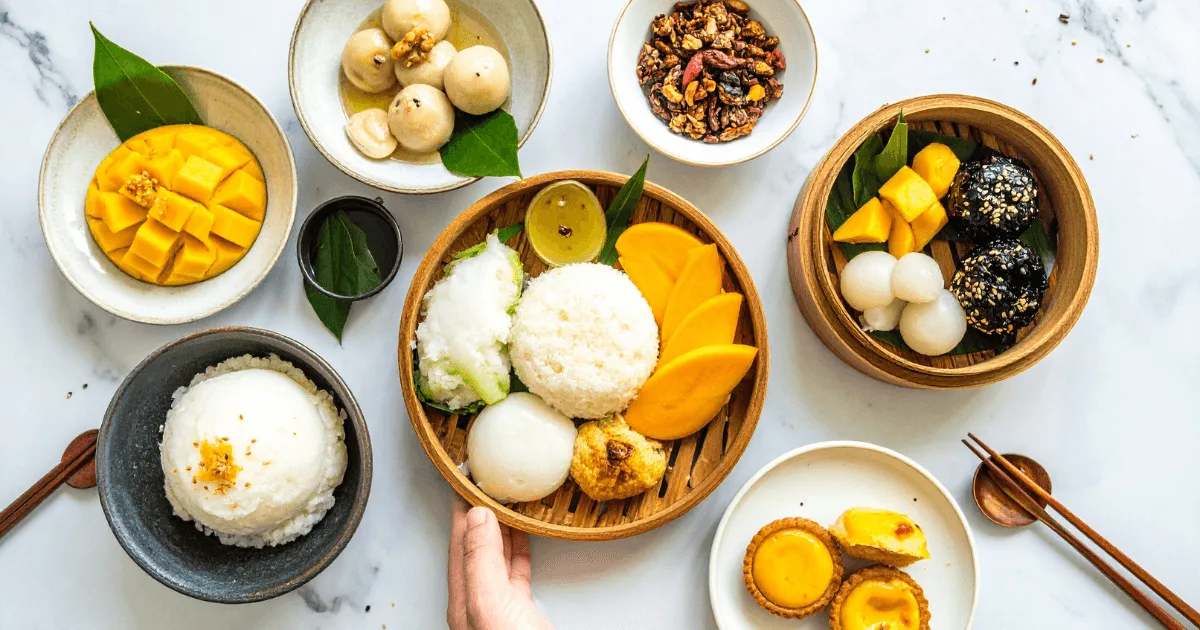I’m on board for the international popularity of Asian desserts! If you haven’t sampled them before, you’re about to enjoy something special. They’re not just about sugar; it’s all about unique textures and subtle, amazing flavors.
Plus, there’s always a cool story or a tradition behind them. I’ve put together a guide to my six favorite recipes that you can make yourself. We’re diving into everything from cloud-soft sponge cake to the pure joy of mango sago. Get set, your palate is about to be delighted.
Table of Contents
Why Asian Desserts Are Captivating the World
A Blend of Art, Flavor, and Tradition
Asian Desserts are akin to edible art pieces. Japan provides intricate wagashi, Korea and Taiwan highlight vivid shaved ice towers, and the current internet hits are mochi or ube cakes that beg to be captured in photos. (Their main role is truly to appear beautiful.)
But they’re not just about looks. These recipes have been around forever, and yet, they keep evolving. Take Hong Kong egg tarts—they started with a Western influence, but now they’re a national treasure.
Unique Ingredients That Do the Heavy Lifting
Part of what makes Asian sweets so fun is the ingredient lineup. Forget butter overload—you’ll often see:
- Thanks to glutinous rice flour, mochi and sesame balls have a chewy texture.
- Coconut milk – Southeast Asia’s secret weapon for creaminess.
- Beans – Yup, sweet beans like red bean or mung bean paste. Way tastier than they sound.
- Tropical fruits – Mango, lychee, jackfruit, durian (if you’re brave).
- Pandan leaves – Southeast Asia’s answer to vanilla, but green and aromatic.
- Palm sugar – Adds a caramel-like depth that regular sugar can’t touch.
The combination means these desserts often feel lighter, fresher, and way more complex than your average cupcake.
Culture in Every Bite
Here’s the thing: these aren’t just desserts—they’re little cultural snapshots. Tangyuan represents family togetherness during the Chinese New Year. Mooncakes at the Mid-Autumn Festival signify togetherness. Halo-halo at a street stall in Manila means summer happiness.
And now? They’ve gone global. Cafés in London, New York, and Paris serve matcha cheesecakes, bingsu, or bubble tea desserts. Savoring Asian confections serves as a ticket to exploring a different culture.
Essential Ingredients & Tools for Asian-Inspired Baking
Pantry Staples You’ll Want Around
- Glutinous rice flour (mochi, sesame balls, tangyuan… trust me, you’ll use it)
- Coconut milk/cream (your mango sticky rice will thank you)
- Sweet red bean paste (classic for fillings)
- Matcha powder (instant “fancy café” vibes)
- Purple yam magic: Ube in ice cream, cakes, or jam
- Tropical fruits (mango, lychee, jackfruit, dragonfruit if you’re feeling extra)
- Condensed/evaporated milk (key for halo-halo or bingsu)
Handy Tools
- A steamer (mochi and steamed cakes are calling)
- A wok or skillet (for frying up crispy sesame balls)
- A shaved ice machine (optional, but bingsu will change your life)
- Tart pans or molds (for those buttery egg tarts)
How to Make 6 Popular Asian Desserts
Mango Sticky Rice (Khao Niaow Mamuang)
This Thai dessert is like a little vacation on a plate. Envision rich coconut rice surrounding the revitalizing essence of cool mango. Perfect combo, right?
- 1 cup sticky (glutinous) rice
- 1 ½ cups coconut milk (split it)
- Sugar (1/3 cup plus 2 tbsp)
- A pinch of salt
- Toasted sesame seeds or mung beans for a little crunch
- 2 big, ripe mangoes (Ataulfo or Champagne mangoes if you can find them)
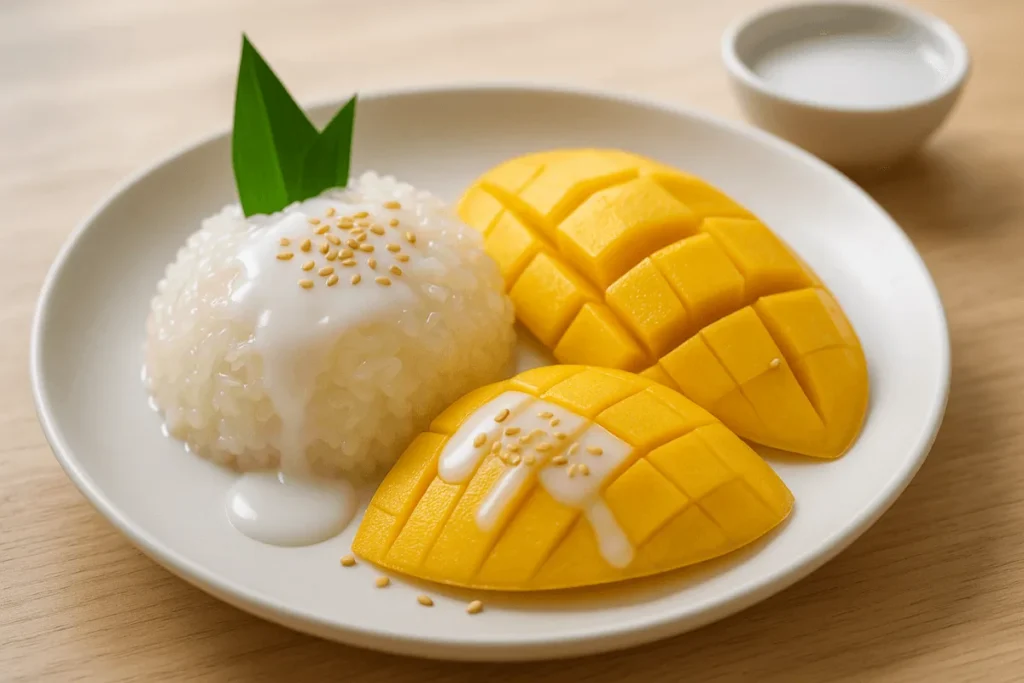
The Magic Steps:
- Rinse the rice thoroughly until the water is clear, then soak it for at least 4 hours (overnight is even better).
- Steam the rice in a lined steamer for approximately 20-25 minutes, or until tender.
- Warm up 1 cup of coconut milk with most of the sugar and salt—slow and low heat, don’t boil!
- Mix the coconut sauce with the hot rice and allow it to sit for 20-30 minutes to let the flavors meld.
- Heat the rest of the coconut milk and sugar for a topping sauce, letting it thicken a little.
- Slice your mango and plate it with the sticky rice; drizzle the sauce, and sprinkle with toasted sesame seeds.
- Serve it up and watch everyone swoon.
Japanese Mochi (Ichigo Daifuku)
A cute, chewy mochi envelops a juicy strawberry and sweet red bean paste in this version. It’s like a fruity surprise inside a squishy pillow.
Ingredients:
- 1 cup mochiko (glutinous rice flour)
- ¼ cup sugar
- 1 cup water
- To avoid sticking, apply cornstarch or potato starch
- 4-6 strawberries (tops off and dry!)
- ½ cup sweet red bean paste (anko)

How to Rock It:
- First, wrap each strawberry with a little red bean paste ball — like strawberry snugglers.
- Mix mochiko and sugar, then slowly whisk in the water until it’s smooth.
- Microwave covered for 1 minute, stir the contents, then microwave for another minute and stir again.. It’ll get sticky and translucent — if not, continue with 30-second boosts.
- Cover your workspace with starch and set the heated dough onto it. Dust your hands, too! Flatten into a square.
- Cut into pieces, flatten each, place the strawberry in the middle, and gently wrap the dough around it like a warm hug. Sprinkle additional starch to avoid it sticking.
- Let them rest a bit, then dig in! Pro tip: Eat them the same day for maximum fluffiness.
Halo-Halo – The Ultimate Filipino Ice Party
‘Halo-Halo’ signifies ‘mix-mix,’ embodying the essence of this scrumptious chilled dessert. It’s a smoothie of toppings, crushed ice, and sweet milky goodness.
Pick Your Faves:
- Crushed or shaved ice
- Evaporated or condensed milk (for extra sweetness)
- Sweet bananas, kidney beans, coconut strips, nata de coco, palm fruit, jackfruit, sago pearls, sweet corn… the list goes on!
- Top it with ube ice cream, leche flan slice, and a sprinkle of crispy toasted rice (pinipig)
The Easy Drill:
- Layer your chosen goodies in a tall glass—use just a spoonful of each so it doesn’t become a fruit jungle.
- Pile crushed ice to the top.
- Pour milk until it reaches halfway.
- Crown with ube ice cream and flan.
- Now, the best part: mix it all up and enjoy! It’s a party in your mouth.
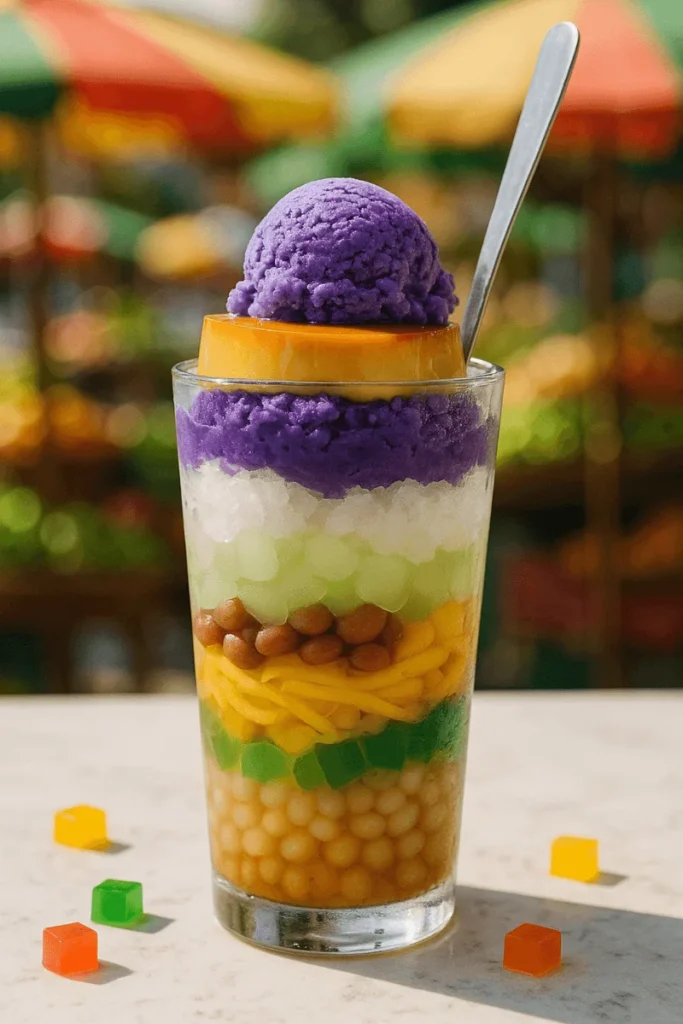
Chinese Sesame Balls (Jian Dui)
These bad boys are fried to perfection — crispy outside, chewy inside, and packed with sweet bean paste.
Gather This Stuff:
- 1 cup glutinous rice flour
- ¼ cup sugar
- About ¾ cup warm water
- ½ cup sweet red bean paste
- ½ cup white sesame seeds
- Vegetable oil for frying (let’s get crispy!)
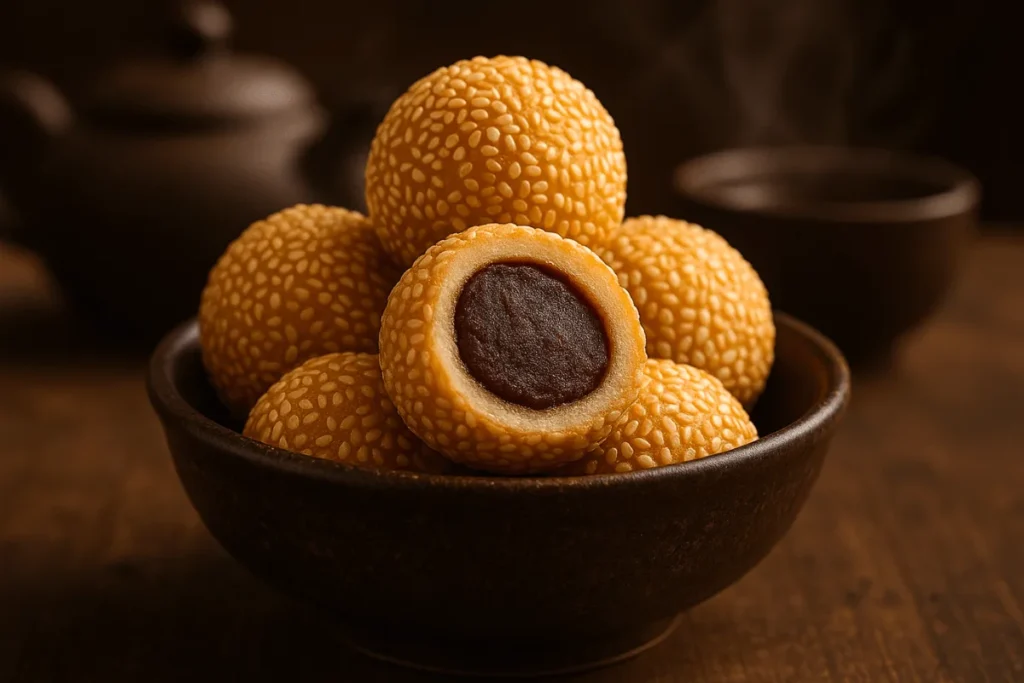
Let’s Fry It Up:
- Mix flour and sugar, then slowly add warm water until you get a soft dough (not sticky). Knead a bit.
- Cut the dough into 12 sections, and also form the filling into small balls.
- Flatten the dough, pop in the bean paste, wrap it up tight, and roll into smooth balls. Seal them well, or you’ll have messy explosions later.
- Dip the balls in water, then coat with sesame seeds.
- Fry in oil at medium-low heat till pale and floating (about 6-8 minutes).
- Increase the heat to medium-high and fry until golden and puffed (another 5-7 minutes).
- Drain and cool slightly. Bite when still warm for the perfect chew.
Korean Bingsu (Patbingsu)
Envision a soft and fluffy shaved ice combined with sweet beans, chewy rice cakes, and fresh fruit.
Grab This:
- Frozen whole milk (in blocks or trays)
- ½ cup sweet red bean paste
- ¼ cup chopped rice cakes (tteok) or injeolmi powder
- Fresh peach or strawberries
- Condensed milk for the sweet drizzle
How to Make It Cool:
- Transform your frozen milk into fluffy snow by shaving it with an ice shaver, blender, or food processor.
- Heap it in a bowl.
- Top with red bean paste, rice cakes, and fruit.
- Drizzle that yummy condensed milk all over.
- Serve immediately and enjoy the cool, creamy, sweet, chewy combo.
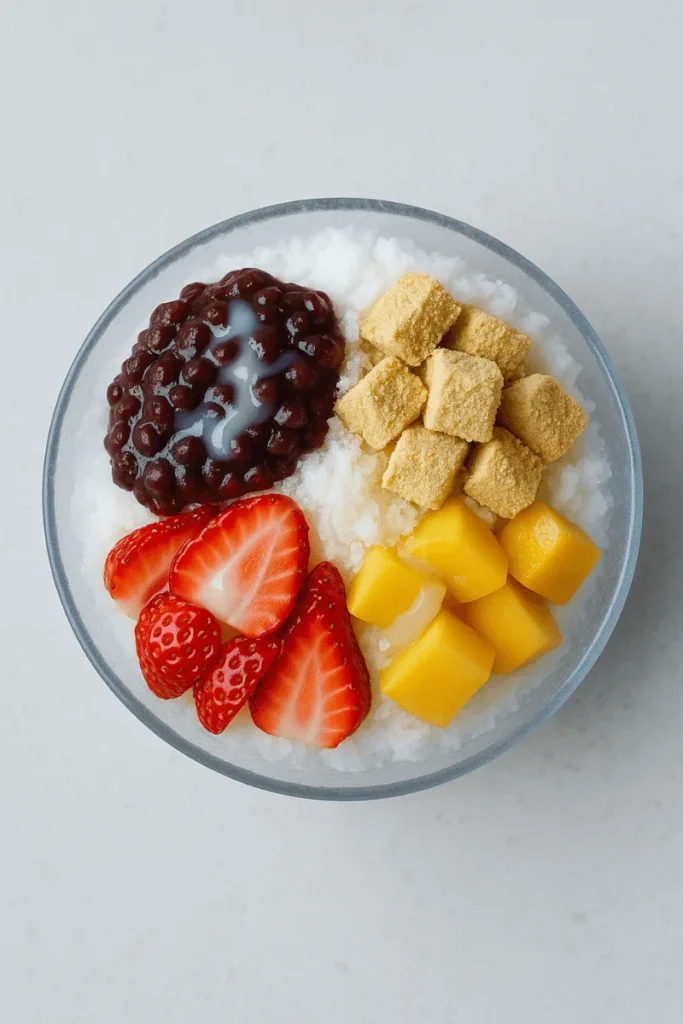
Hong Kong Egg Tarts (Dan Tat)
These custard tarts have a crispy, buttery shell and silky smooth filling — so good, you’ll want to eat a dozen.
Ingredients for the Crust:
- 1 ½ cups all-purpose flour
- ½ cup powdered sugar
- ½ cup cold unsalted butter (cubed)
- 1 egg yolk
- 1-2 tbsp cold water
For the Filling:
- 3 eggs
- ½ cup sugar
- ¾ cup hot water
- ⅔ cup evaporated milk
- 1 tsp vanilla extract
Let’s Bake:
- Pulse flour, sugar, and butter in a food processor till crumbly. Add egg yolk and 1 tbsp water and pulse till dough forms. Chill for 30 minutes.
- Preheat oven to 350°F (175°C).
- Mix sugar into hot water until dissolved, then allow it to cool. Whisk the eggs softly, then add evaporated milk, vanilla extract, and the sugar solution. Strain for a smooth texture.
- Roll the dough and cut circles a bit bigger than your tart pans. Press the dough evenly.
- Fill with custard about 80% full. Bake for 15-20 minutes until just set with a little wobble and golden edges.
- Cool before removing so the custard firms up nicely.
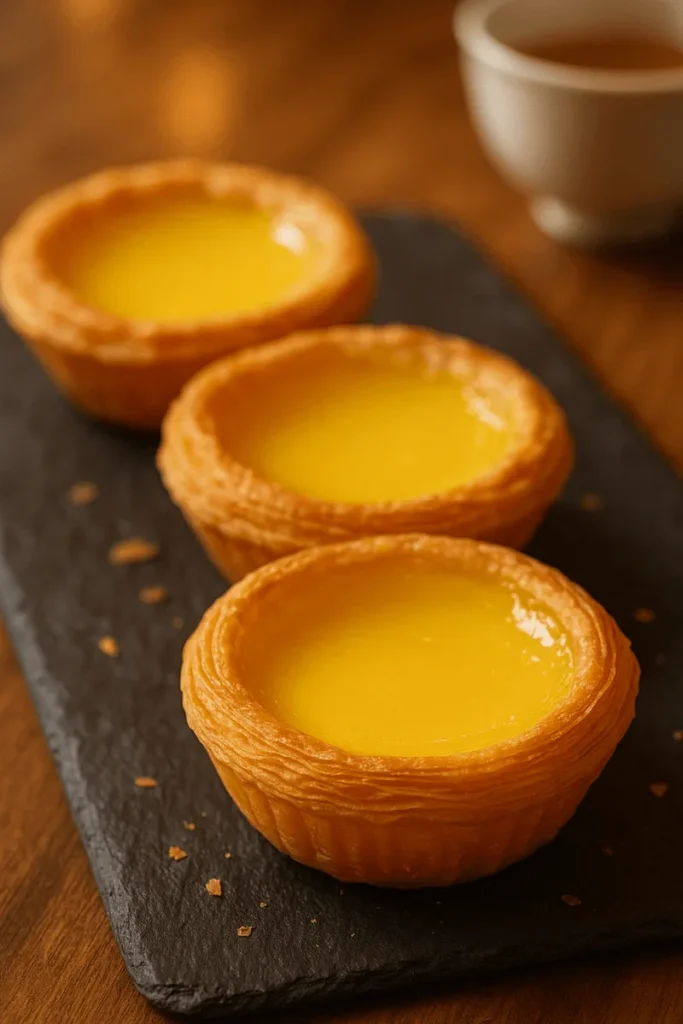
Tips for Perfecting Asian Desserts
- Use fresh ingredients (especially coconut milk and fruit).
- Don’t overdo sugar—keep that balanced sweetness.
- Play with textures—chewy, crunchy, jelly-like are all good things.
- Make it pretty—plating is part of the experience.
- Go vegan if you want—coconut milk swaps in perfectly.
Conclusion
Asian desserts aren’t just sweet—they’re stories. From mango sticky rice’s tropical comfort to halo-halo’s crazy party glass, each bite has history and culture behind it.
What’s even better? There’s no need to reserve a flight to enjoy them. Just collect some key ingredients, spend some time cooking, and you’ll be traveling the globe via dessert.
Trust me—once you’ve made one, you’ll want to try them all.
FAQ
What are the most popular Asian desserts?
Mochi, mango sticky rice, halo-halo, egg tarts, bingsu, gulab jamun, and ube treats.
What are 10 Chinese desserts?
Mango pancake, mango sago, sesame balls, tangyuan, mooncakes, red bean soup, egg tarts, almond jelly, snow skin mooncakes, fried milk.
What’s an easy Asian dessert to make at home?
Mango sago, halo-halo, or tangyuan—mostly assembly, minimal cooking.
What is a zillionaire dessert?
The provided sources do not contain any information about a dessert referred to as a “zillionaire dessert.” This may be a modern, Western-style dessert or a term not widely recognized in the context of traditional Asian sweets.

